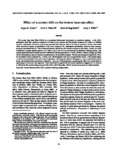Effect of a context shift on the inverse base rate effect
| dc.contributor.author | Inkster, A | |
| dc.contributor.author | Mitchell, C | |
| dc.contributor.author | Schlegelmilch, R | |
| dc.contributor.author | Wills, Andy | |
| dc.date.accessioned | 2022-04-25T15:17:07Z | |
| dc.date.issued | 2022-04-25 | |
| dc.identifier.uri | http://hdl.handle.net/10026.1/19069 | |
| dc.description.abstract |
<jats:p>The Inverse Base Rate Effect (IBRE) is a non-rational behavioural phenomenon in predictive learning. In the IBRE, participants learn that a stimulus compound AB leads to one outcome and that another compound AC leads to a different outcome. Importantly, AB and its outcome are presented three times as often as AC (and its outcome). On test, when asked which outcome to expect on presentation of the novel compound BC, participants preferentially select the rarer outcome, previously associated with AC. This is irrational because, objectively, the common outcome is more likely. Usually, the IBRE is attributed to greater attention paid to cue C than to cue B, and so is an excellent test for attentional learning models. The current experiment tested a simple account of attentional learning proposed by Le Pelley, Mitchell, Beesley, George, and Wills (2016) where attention paid to a stimulus is determined by its associative strength. This account struggles to capture the IBRE, but a potential solution presented by Le Pelley et al. (2016) appeals to the role of experimental context. In the present paper, we derived four predictions from the context explanation concerning the effect of changing to a novel experimental context at test, and examined these predictions empirically. Only one of the predictions, concerning the effect of a context shift on responding to a novel cue, was supported. These results fail to support both the context explanation suggested by Le Pelley et al. (2016) and the current leading account of the IBRE, EXIT (Kruschke, 2001b), but provide avenues for further research. Keywords: Inverse base-rate effect, EXIT, predictive learning, categorization</jats:p> | |
| dc.format.extent | 22-29 | |
| dc.language.iso | en | |
| dc.publisher | Nurture Science Publishing Group | |
| dc.subject | Mental health | |
| dc.title | Effect of a context shift on the inverse base rate effect | |
| dc.type | journal-article | |
| plymouth.volume | 1 | |
| plymouth.publication-status | Published online | |
| plymouth.journal | Open Journal of Experimental Psychology and Neuroscience | |
| dc.identifier.doi | 10.46221/ojepn.2022.0404 | |
| plymouth.organisational-group | /Plymouth | |
| plymouth.organisational-group | /Plymouth/Admin Group - REF | |
| plymouth.organisational-group | /Plymouth/Admin Group - REF/REF Admin Group - FoH | |
| plymouth.organisational-group | /Plymouth/Faculty of Health | |
| plymouth.organisational-group | /Plymouth/Faculty of Health/School of Psychology | |
| plymouth.organisational-group | /Plymouth/REF 2021 Researchers by UoA | |
| plymouth.organisational-group | /Plymouth/REF 2021 Researchers by UoA/UoA04 Psychology, Psychiatry and Neuroscience | |
| plymouth.organisational-group | /Plymouth/Research Groups | |
| plymouth.organisational-group | /Plymouth/Research Groups/Institute of Health and Community | |
| plymouth.organisational-group | /Plymouth/Users by role | |
| plymouth.organisational-group | /Plymouth/Users by role/Academics | |
| dcterms.dateAccepted | 2022-04-25 | |
| dc.rights.embargodate | 2022-5-28 | |
| dc.rights.embargoperiod | Not known | |
| rioxxterms.versionofrecord | 10.46221/ojepn.2022.0404 | |
| rioxxterms.licenseref.uri | http://www.rioxx.net/licenses/all-rights-reserved | |
| rioxxterms.type | Journal Article/Review |


